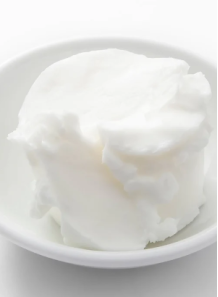Butter Cream Maker™
- Product Code: 1041
Emulsifier with special properties, can withstand high electrolyte and wide pH range of 3-12, resistant to all environmental conditions, can integrate oil up to 30%.
Non-ionic
Emulsifier with special properties, can withstand high electrolyte and wide pH range of 3-12, resistant to all environmental conditions, can integrate oil up to 30%.
Non-ionic
Butter Cream Maker™ Emulsifier with special properties, high electrolyte resistance and wide pH range of 3-12, resistant to all environmental conditions, can emulsify up to 30% oil.
Use at a rate of 2-3% to get a smooth, soft and thick cream.
Use at a rate of 5-6% to get a solid creamy texture similar to butter (butter) when used together with Cetyl Alcohol (Vegetable) at 10% (please see the example butter texture recipe below).
Butter Cream Maker™ has good electrolyte resistance and can be combined with up to 30% oil. It is suitable for recipes that require high acidity or alkalinity or high electrolyte.
Examples of ingredients and steps for using the Butter Cream Maker™ in various recipes.
AHA cream (Lactic Acid 10%) which is highly acidic and difficult to create a formula with other types of Cream Makers.
1.Water 80%
2. Lactic Acid 10% ( Lactic Acid has a strong smell. It can be changed to Glycolic Acid instead, which will not have a problem with smell and is more effective at exfoliating skin cells, but is more expensive.)
3. Butter Cream Maker™ 4% + Cetyl Alcohol 5% (If you want it thicker, consider adding Beeswax)
4. Phenoxyethanol SA 1%
step
Combine ingredients 1,2,3, heat to 80 degrees and blend or stir until blended. Let it cool to 50 degrees and then add 4 to the cream. Stir until blended.
Azelaic Acid cream is highly electrolytic and is difficult to formulate with other types of Cream Makers.
1. Water to 100%
2. Liquid Azelaic™ 20% (Caution: Azelaic Acid should not be used in cosmetics at levels exceeding 10%. This sample is intended to test the emulsifying power of Butter Cream Maker™ only, demonstrating that Butter Cream Maker™ emulsifies even at very high electrolyte levels in the formula.)
3. Butter Cream Maker™ 4% + Cetyl Alcohol 5% (If you want it thicker, consider adding Beeswax)
4. Oil or ester such as LipidSoft Lite or Silicone such as Cyclopentasiloxane 5-15%.
5. Phenoxyethanol SA 1%
Combine ingredients 1,3,4, heat to 80 degrees and blend or stir until blended. Let cool to 50 degrees and add 2,5 to the cream. Stir until blended.
Buttery Cream
1.Water 75%
2. Cetyl Alcohol 6% , Beeswax 4%
3. Fractionated Coconut Oil 10%
4. Butter Cream Maker™ 4%
5. Phenoxyethanol SA 1%
Heat ingredients 2,3,4 at 80 degrees Celsius to melt together into the oil mixture.
Prepare the water part by mixing 1.5 together, then heat it to a temperature close to that of the oil part.
While blending the water mixture, gradually add the oil mixture until all is incorporated. Turn off the heat and blend on low speed until the mixture cools.
Butter Cream Maker™ takes approximately 12 hours to set after mixing, and the formula will thicken gradually from when it was first mixed, which is quite runny.
Use: As an emulsifier, suitable for formulas containing electrolyte or highly acidic ingredients.
Mixing method: Mix in oil-phase. Please see details above.
Usage rate: 2.0-6.0% (Using a higher proportion will allow for higher electrolyte tolerance and thicken the formula)
Product Description: Hard wax pellets, white-light yellow
Dissolving: Can be dissolved in oil by heating at 70 degrees.
| Mechanism | - |
| Appearance | - |
| Longevity | - |
| Strength | - |
| Storage | - |
| Shelf Life | - |
| Allergen(s) | - |
| Dosage (Range) | - |
| Recommended Dosage | - |
| Dosage (Per Day) | - |
| Recommended Dosage (Per Day) | - |
| Mix Method | - |
| Heat Resistance | - |
| Stable in pH range | - |
| Solubility | - |
| Product Types | - |
| INCI | - |
Purchase History for
Cart
No products



